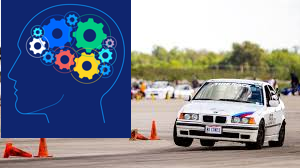Autocross is an exhilarating motorsport that requires both physical and mental preparation. While many drivers focus on the physical aspects of performance, such as car setup and technique, the mental game is equally important. In this article, we'll explore the psychology of autocross, including how to overcome anxiety and build confidence on the course.
Understanding Autocross Anxiety
Anxiety is a common feeling among autocross drivers, particularly those new to the sport. The pressure of competition, the technical aspects of the course, and the fear of making a mistake can all contribute to feelings of anxiety. These feelings can manifest as physical symptoms, such as racing heart, sweaty palms, and shallow breathing.
The first step in overcoming autocross anxiety is to understand its root causes. By identifying what triggers your anxiety, you can take steps to address it. For example, if you feel anxious about making a mistake, focus on learning from your mistakes rather than dwelling on them.
Visualization and Positive Self-Talk
Visualization and positive self-talk are powerful tools for building confidence and reducing anxiety. Visualization involves mentally rehearsing your performance on the autocross course. Picture yourself driving smoothly and confidently, hitting each apex and accelerating out of each turn. This mental rehearsal can help build muscle memory and reduce anxiety.
Positive self-talk involves using affirmations to boost your confidence and reduce negative self-talk. For example, instead of saying "I'm not good enough," say "I am a skilled driver, and I can handle this course." By reframing your thoughts in a positive light, you can build confidence and reduce anxiety.
Breathing and Relaxation Techniques
Breathing and relaxation techniques can also help reduce anxiety and build confidence. When we feel anxious, our breathing tends to become shallow and rapid, which can exacerbate feelings of panic. Taking slow, deep breaths can help regulate your breathing and reduce anxiety.
Relaxation techniques, such as progressive muscle relaxation or meditation, can also help calm your mind and reduce anxiety. Find a technique that works for you and practice it regularly, both on and off the course.
Conclusion
The psychology of autocross is a critical aspect of performance that is often overlooked. By understanding the root causes of anxiety, using visualization and positive self-talk, and practicing breathing and relaxation techniques, you can overcome anxiety and build confidence on the course. Remember, autocross is a challenging sport that requires both physical and mental preparation. By taking care of your mental health, you can become a more confident and successful driver.

